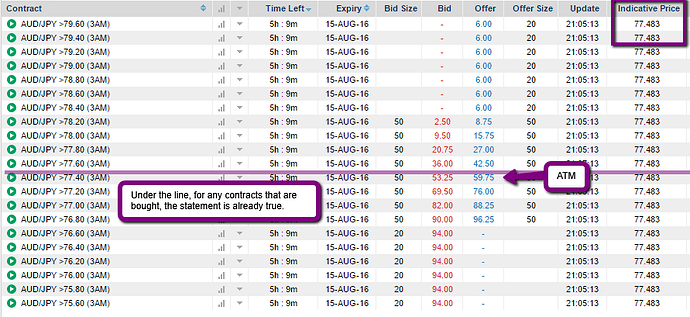By Darrell Martin
When trading binary options, you see or hear ITM, OTM and ATM regularly, but what do they mean? The short answer is ITM means in the money, OTM indicates out of the money, and ATM stands for at the money. This article will further define what they spell out to traders.
At the money (ATM) pertains to the strike price closest to where the market is trading at the time. Look at the indicative price on a Nadex price ladder and then find the binary priced closest to 50, this is the At The Money (ATM) binary. The expiration time has no effect on at the money. At expiration, the binary either wins or loses. It is worth 100 or 0. When you think about it, 50 is right in the middle, which makes sense that at the money would be priced at about 50. This is very important to understand.
Look at the image below. You can see the indicative price is 18550. The strike with the binaries priced closest to 50 is 18550. Bid price is 49.50. Offer price is 54.75.
ATM binaries have a 50/50 chance of profiting at the current time. In the example above, the market might or might not be at 18550 at expiration.Out of the money (OTM) are the strikes beyond the current market. If long, then higher than the market and if short, then lower than the market. If you buy a binary with a strike that is way above the market, you are saying that the market has to move all the way up to and one pip or tick beyond (greater than), that strike point for that strike to expire profitably. OTM binary options have no intrinsic value, only extrinsic or time value.
In the money (ITM) are the strikes priced higher because the statement is already true. If you buy an ITM binary, you have three ways to profit: The market can keep going up, stay flat or even move down, as long as it remains above your strike price. An ITM binary has a much higher probability that it will profit due to the market already being beyond the strike. When buying a binary, the amount of profit you make is the difference between where you bought and $100. For example, if you bought at $75, you would make $25 at expiration, since 100 – 75 = 25.
Knowing that at the money is about 50, this splits all the strike offerings in half when you look at the price ladder.
All strikes below 50 are below current market. If you buy a strike below this point, you are saying the market will expire above that strike price and the statement is already true.
Knowing more about in the money, out of the money and at the money in relation to the current market and strike prices will make trading binary options easier and hopefully, more profitable.


